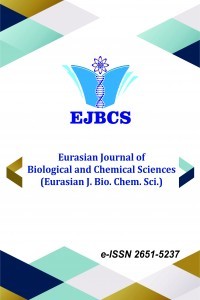Beta Glucosidase Recognition By Imprinted Polyacrylamide Hydrogels
Beta Glucosidase Recognition By Imprinted Polyacrylamide Hydrogels
β-Glucosidase, polyacrylamide, hydrogel,
___
- Bhattacharyya R and Ray SK 2013. Kinetic and equilibrium modeling for adsorption of textile dyes in aqueous solutions by carboxymethyl cellulose/poly(acrylamide-co-hydroxyethyl methacrylate) semi-interpenetrating network hydrogel. Polym Eng Sci 53(11):2439–2453.
- Çelik A, Dinçer A, Aydemir T 2016. Characterization of β-glucosidase immobilized on chitosan-multiwalled carbon nanotubes (MWCNTS) and their application on tea extracts for aroma enhancement. Int J Biol Macromol 89:406–414.
- Ghasemzadeh N, Nyberg F, Hjerten S 2008. Highly selective artificial gel antibodies for detection and quantification of biomarkers in clinical samples. I. Spectrophotometric approach to design the calibration curve for the quantification. J Sep Sci 31(22):3945-3953.
- Gómez JM, Romero MD, Fernández TM, Díez E 2012. Immobilization of β-glucosidase in fixed bed reactor and evaluation of the enzymatic activity. Bioprocess Biosyst Eng 35:1399–1405.
- Grover AK, Macmurchie DD, Cushley RJ 1977. Studies on almond emulsin beta-D-glucosidase. I. Isolation and characterization of a bifunctional isozyme. Biochim Biophys Acta. 482(1):98-108.
- Hawkins DM, Derek S, Subrayal MR 2005. Investigation of protein imprinting in hydrogel-based molecularly imprinted polymers (HydroMIPs) Anal Chim Acta 542:61–65.
- Hjerten S, Liao JL, Nakazato K, Wang Y, Zamaratskaia G, Zhang HX 1997. Gels mimicking antibodies in their selective recognition of proteins. Chromatographia 44(5-6):227-234.
- Kempe M, Mosbach K 1994. Direct resolution of naproxen on a non-covalently molecularly imprinted chiral stationary phase J Chromatogr A 664 (2):276–279.
- Li Z, Day M, Ding J, Faid K 2005. Synthesis and Characterization of functional methacrylate copolymers and their application in molecular imprinting. Macromolecules 38: 2620-2625.
- Lv Y, Tan T, Svec F 2013. Molecular imprinting of proteins in polymers attached to the surface of nanomaterials for selective recognition of biomacromolecules, Biotechnol Adv 31:1172–1186.
- Nishino H, Huang CS, Shea KJ 2006. Selective protein capture by epitope imprinting. Angew Chem 118:2452 –2456.
- Pan J, Xue X , Wang J, Xie H, Wua Z 2009. Recognition property and preparation of Staphylococcus aureus protein A-imprinted polyacrylamide polymers by inverse-phase suspension and bulk polymerization. Polymer 50:2365–2372.
- Pisarev OA, Polyakova IV 2018. Molecularly imprinted polymers based on methacrylic acid and ethyleneglycol dimethacrylate for L-lysine recognition. React Funcnt Polym 130:98-110.
- Tong D, Heényi C, Bikádi Z, Gao J, Hjertén S 2001. Some studies of the chromatographic properties of gels (‘Artificial antibodies/receptors’) for selective adsorption of proteins. Chromatographia 54(1):7-14.
- Verheyen E, Schillemans JP, Wijk M, Demeniex MA, Hennink WE, Nostrum CF 2011. Challenges for the effective molecular imprinting of proteins, Biomaterials 32:3008-3020
- Verma OP, Singh A, Singh N, Chaudhary O 2011. Isolation, purification and characterization of β-glucosidase from Rauvolfia serpentina. J Chem Eng Process Technol 2:5.
- Wanga DD, Gao D, Xu WJ, Li F, Yin MN, Fu QF, Xi ZN 2018. Magnetic molecularly imprinted polymer for the selective extraction of hesperetin from the dried pericarp of Citrus reticulata Blanco. Talanta 187:307-315.
- Zaidi SA 2018. Development of molecular imprinted polymers based strategies for the determination of Dopamine. Sensor Actuat B Chem 265:488-497.
- Zhao K, Chen T , Lin B, Cui W , Kan B , Yang N, Zhou X, Zhang X, Wei J 2015. Adsorption and recognition of protein molecular imprinted calcium alginate/polyacrylamide hydrogel film with good regeneration performance and high toughness. React Funcnt Polym 87:7–14.
- Zhao M, Chen X, Zhang H, Yan H, Zhang H 2014. Well-defined hydrophilic molecularly imprinted polymer microspheres for efficient molecular recognition in real biological samples by facile RAFT coupling chemistry. Biomacromolecules 15(5):1663-75.
- Yayın Aralığı: Yılda 2 Sayı
- Başlangıç: 2018
- Yayıncı: Muhammet DOĞAN
Kübra UĞUR, Muhammet DOĞAN, Abdullah KAYA
Beta Glucosidase Recognition By Imprinted Polyacrylamide Hydrogels
Mervecan SEVİLDİK, Ayşe DİNÇER, Tülin AYDEMİR
Erol ATAY, Levent EFİL, Mahmut TATLI, Berrin ALACA
Ayşen AKTÜRK, Büşra CENİK, Zeliha AYDOĞDU, Melek EROL TAYGUN, Funda KARBANCIOĞLU GÜLER, Sadriye KÜÇÜKBAYRAK
Meliha KOLDEMİR GÜNDÜZ, Mehtap ÇEVİK, Penbe ÇAĞATAY, Belgin SÜSLEYİCİ
